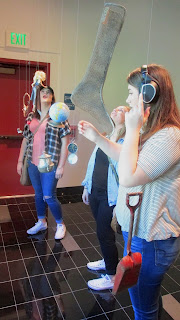Sherlock Holmes like you’ve never seen at Lakewood Playhouse
Published in the Weekly
Volcano, Sept. 29, 2016
 |
from left – Kayla Crawford as Dr. Watson, Gary Chambers as Sir Henry Baskerville, and Jacob Tice as Sherlock Holmes. Photo by Tim Johnson |
The
Hound of the Baskervilles at Lakewood
Playhouse is not the spooky version of the story by Sir Arthur Conan Doyle but
a spoof on it by Stephen Canny and the British comedy troupe Peepleykus
(pronounced people like us). It is a Monty Python-style skit expanded to about
two-and-a-half hours with bits apparently inspired by the Reduced Shakespeare
Company and perhaps the Marx Brothers and the old Carol Burnett TV show — not
to mention The 39 Steps, which
director John Munn also directed at Lakewood Playhouse.
Like
The Complete Works of Shakespeare (Abridged),
the actors even stop at one point and replay the whole thing in a super-fast
speeded-up version. And they not only break the mythical fourth wall, they
shatter it to smithereens, even to the point of introducing themselves to the
audience as themselves rather than as the characters they play, and they
criticize one another’s acting.
Yes,
it is madcap, insane, and a daunting challenge to the director, actors and
three-person backstage crew, all of whom together shall forever be known as the
Magnificent Seven. The marvel is they almost pull it off. Almost. There are
moments of comic genius and amazing acting, not to mention feats of backstage
magic we can only surmise. But despite all this, I found myself at times
wishing they would just get on with it and finish it up. Not all of it was as
funny as hoped for. I noticed on the night I attended that the audience
laughed, but not wildly, and sat stone-faced through long scenes.
Three
actors each play one major character and many others. The press release said 50
different characters. I didn’t try to keep count. I just know that many of them
were named Baskerville and were played by Gary Chambers; Sherlock Holmes and a
lot of other men and women were played by Jacob Tice, and Dr. Watson was played
by Kayla Crawford. Of the three actors, Crawford plays her part almost without
comic exaggeration. Chambers is rubber-faced and crazily funny, and Tice is not
only rubber-faced but also rubber-bodied, with movements that bring to mind
Monty Python’s “Ministry of Silly Walks.”
There’s
a great segment in a steam room with Watson (remember, she’s a woman in this
version) trying to maintain her dignity when the two men keep dropping their
towels, and a funny dance scene with Tice as a woman dancing with Chambers, and
hilarious bits with a stuffed doll sporting Chambers’ long pony tail (he’s
supposedly a dead member of the Baskerville family), and a scene on a train
where Tice plays a conductor with a voice like the monster in Young Frankenstein, and a great little
scene with Chambers and Crawford playing patty cake/hand jive. If you like such
Vaudeville-type silliness, you’ll love this Hound
of the Baskervilles.
The
Hound of the Baskervilles,
8 p.m. Friday and Saturday, 2 p.m. Sunday, through Oct. 9, Lakewood Playhouse, 5729
Lakewood Towne Center Blvd., Lakewood, $25, $22 military,
$21 seniors and $19 students/educators, 253.588.0042, www.lakewoodplayhouse.org


















